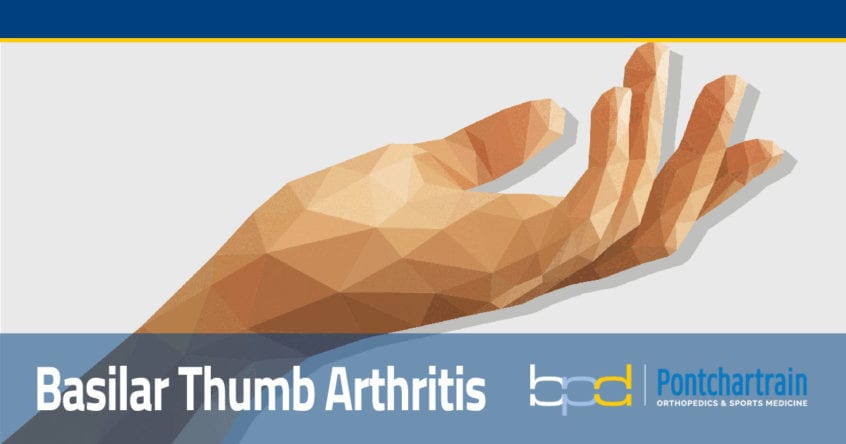What is Basilar Thumb Arthritis?
The basilar joint is located at the base of the thumb where it meets up with the wrist. This joint, is also known as the CMC (carpometacarpal joint) or trapeziometacarpal joint, is a specialized saddle-shaped joint that is formed by a small bone of the wrist (trapezium) and the first bone of the thumb (metacarpal). The saddle shaped joint allows the thumb to have a wide range of motions, including up, down, across the palm, and the ability to pinch. Because it is constantly used when pinching and gripping objects, it is susceptible to basilar thumb arthritis.
Arthritis at the base of the thumb is more commonly seen in women over the age of 40. Common symptoms of basilar thumb osteoarthritis include:
- Pain at the base of the thumb when pinching or gripping, such as opening jars or turning doorknobs
- Swelling
- Tenderness
- Weakness
- Loss of motion
The exact cause is unknown, but genetics, previous injuries such as fractures or dislocations, and generalized joint laxity may predispose towards development of this type of arthritis.
How is Basilar Thumb Arthritis Diagnosed?
A patient history including previous injuries to the hand and thumb is obtained. Activity level, hobbies, and occupation are noted. A thorough examination of the hand and thumb is performed. Stability of the thumb CMC joint and stressing of joint assessing for grinding often reproduces the pain. The next joint above the CMC is also tested, as severe cases can lead to compensatory hyperextension instability of this joint known as the metacarpophalangeal joint (MCP).
X-rays are taken to evaluate the severity of arthritis, and assess neighboring joints for involvement.
How is Basilar Thumb Arthritis Treated?
Treatment is dependent on severity. Less severe cases are often amenable to non-surgical treatments such as:
- Activity modification. Slowing down or stopping movements that produce pain.
- Nonsteroidal anti-inflammatory drugs. Over-the-counter and prescription medications that decrease inflammation and pain.
- Ice. Icing the joint and painful areas.
- Splinting. A splint supports the thumb and takes pressure off the joint. Ideal splints support the base of the thumb, while keeping the wrist and finger free.
- Steroid injections. Fast acting anti-inflammatory medication are injected into the arthritic joint to help relieve pain. Pain relief is often unpredictable, but often several months of relief are possible.
Patients who have failed conservative treatments are candidates for surgical treatment. A variety of surgical techniques are available that can successfully reduce or eliminate pain. Surgical procedures include removal of arthritic trapezium bone and joint reconstruction (arthroplasty), joint fusion, bone realignment, and even arthroscopy in select cases.
Which procedure is best is determined based on several factors, including severity of disease, occupation, and activity level.

